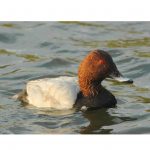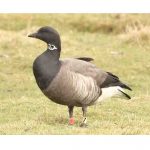A dramatic red sky in the morning on Saturday 10th February was the sure sign of a shepherd’s warning, as 10 indefatigable members, led by Ken and Sarah White, converged on Titchfield Haven National Nature Reserve, just west of Gosport on the Solent; this reserve has the fabulous combination of a visitor centre & cafeteria, plus 7 strategically placed hides overlooking the freshwater river, lagoons and meadows of the River Meon right next to the high water level of the Solent coast. Early RDNHS arrivals to the beach-side car parking found groups of waders sitting out the early morning high tide on the shingle foreshore including Dunlin, Ringed Plover and Sanderling. A 30-strong flock of very confiding Turnstone joined the Mallard, Pochard and Black-headed Gulls at the Meon sluice gates in the small Hill Head Harbour, awaiting food handouts from sympathetic passers-by.
Once assembled, the group set off for the southernmost Meon Shore lagoon hide; large numbers of Teal filled the pool. Some were roosting, some were feeding but quite a few were in small groups frantically displaying to each other, the males expanding their head feathers into amazing shapes while exaggerating their striking yellow on black rear ends. Amongst them pairs of Mallard and Gadwall dabbled calmly around the pool margins, while a small group of Shoveler were, like the Teal, amorously displaying, resulting perhaps surprisingly for early February, in one pair mating! Careful scrutiny of the myriad islands and reedy margins resulted in finding several Snipe, who kindly moved onto a grassy bank while feeding, allowing everyone to observe the ease with which they work those extraordinary bills, and a graceful trio of Avocets, also busy with feeding, but this time by sweeping those finely upturned bills from side to side as they do.
Amongst the Teal hogging the islands, plenty of Lapwing also chose these safe spots to roost. A sprinkling of Redshank and Ringed Plover soon left for the foreshore when a Buzzard floated across the back of the lake in a very harrier-like manner. The next hide, the Pumfrett, had no near birds to view at all, and yet the more distant views of Great Black-backed Gulls, with their 5 ft wingspans, patrolling up and down the River Meon in the strengthening winds demonstrated their command of the aerial environment. As we progressed to the final hide of the morning, one of the diligent members recognised the path-side watery habitat as being suitable for Water Voles, and within minutes one was found swimming up a water channel right next to the path! Viewing from the Spurgin Hide, the trio of Avocets had changed pools to just in front of us, initially on their own, but within minutes, ALL the birds from the first lagoon became airborne, spooked presumably by the Buzzard we saw earlier, many of which settled in front of us. Rival pairs of Shelduck postured and displayed to each other, a lovely sight and sound. On our return route towards the cafeteria for lunch, the Water Vole was still there, giving us a second chance to watch it sampling the marginal vegetation. Later on when we met up with the warden, he said that the Water Vole had been recently successfully re-introduced following earlier eradication by mink. Back on the foreshore, in increasingly wet and windy conditions the group caught up with one of the star winter birds here, the Russian Dark-bellied Brent Goose Branta bernicla ssp. bernicla. This population of Brent Geese breed on the Taimyr Peninsula at longitudes around 85 – 95 ̊ East, and every autumn they fly over 3,500 kms to spend the winter in the south of the England and the low countries on the continent. [Seven of the group members had enjoyed, only a month before in Scotland, catching up with the Pale-bellied Brent Goose B.b.ssp. hrota that undertake the autumn migration from Ellesmere Island, Canada.] Small flocks of Oystercatcher, Redshank, Sanderling and Dunlin raced past us disturbed by walkers and wind surfers on the shoreline. At last, amongst the many gulls there were 3 Common Gulls and one Mediterranean Gull.
After a warm and much needed lunch break, we set off up the east side of the reserve to visit 3 more hides; with the wind-driven now horizontal rain, the hides really were a great asset. The Suffern Hide overlooks the River Meon, but the water levels were high and no muddy bank margins were visible. However, some Coot and Little Grebes were worth the stop. The next hide was the most productive, the Meadow Hide, giving great views up and down the valley; flocks of Wigeon, Black-tailed Godwits, Cormorants and Canada Geese also had Teal, Gadwall, Curlew, Mallard and Lapwing amongst them. Two Ravens mobbed another Buzzard, and as we progressed to the final Knights Bank hide, a sprinkling of passerines in the trees and scrub included Goldfinch and Goldcrest, and a nice specimen of Scarlet Elfcup. Increasing wind & rain and decreasing light helped us conclude the winter day’s birding at the Osborne View pub just a mile up the road towards Gosport. The final tally was a very satisfying 55 species of bird, many from distant lands, and some very fine viewing.
Report by Ken White
Pictures by Ken White



